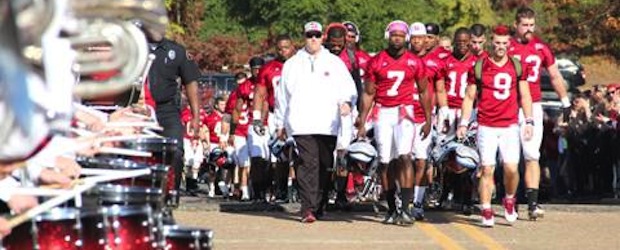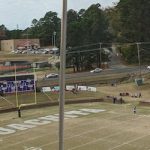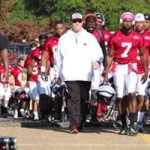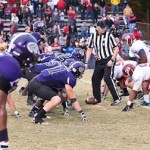 Those who know me well know that my favorite day of the year is the Saturday of the Battle of the Ravine.
Those who know me well know that my favorite day of the year is the Saturday of the Battle of the Ravine.
There have been four Great American Conference championship trophies awarded in football since the GAC came into existence, and all four trophies reside in Arkadelphia — two at Ouachita Baptist University and two at Henderson State University.
Because both football programs have been good in recent years, this unique rivalry has received increased national attention.
Last month, Champion, the official magazine of the NCAA, featured the Battle of the Ravine in a story titled “The short walk.”
Jared Thompson wrote: “One college’s water turned purple. Across the road, red marshmallows rained from the sky. A future state governor set the other school’s party ablaze. One time, a homecoming queen was kidnapped. And no one recalls where the drag queens buried the tiger’s tail.
“This fall marks the 89th edition of the Battle of the Ravine. The pranks defining Division II’s oldest football series have been legendary. The football games have been extraordinary, too. The rivalry pits two schools separated by two lanes of U.S. Highway 67, over which the visiting team walks to its opponent’s field on game day in the shortest road trip in football. The ancestries supporting either side are entwined tighter than the kudzu that suffocates the nearby ravine from which the rivalry’s namesake was found. In Arkadelphia, you grow up cheering either for red or for purple. Yet credits transfer freely between the two schools, and students from one often take classes at the other. Where else might you see the starting quarterback sit next to an opposing lineman in biology class?”
When the writer called me for a quote, I told him that this is the small college version of Alabama-Auburn, a rivalry that divides families. As an Arkadelphia native, I also pointed out that it’s Christmas, New Year’s, Thanksgiving and Valentine’s Day all rolled into one for that town.
“Tiger fans still express zeal about the 1975 matchup,” Thompson wrote. “Ouachita converted a fourth-and-25 play by one inch and scored on its final drive to upset a previously undefeated Henderson team, 21-20. Reddies, meanwhile, point to as recently as 2013, when they emerged victorious after a triple-overtime affair to complete a second consecutive undefeated season. Henderson leads the series 42-40-6. The first game was played in 1895; the matchup was resurrected in 1907 and interrupted for World Wars I and II. Then the pranks and vandalism escalated, and officials suspended the game for 12 years after the 1951 contest. Nowadays, when game week arrives, school signs are wrapped in protective plastic, garbage bags or tarps.”
In the late 1940s, the game was promoted as the Biggest Little Football Game in America, a moniker initially used on the East Coast for the NCAA Division III rivalry between Williams College and Amherst College, who first played in 1884. The Nov. 10, 2007, game between Williams and Amherst in Williamstown, Mass., was selected as the location for ESPN’s popular “College GameDay” program. One of these days, the folks at ESPN will make the wise decision to bring that program to Arkadelphia and show the only time in college football in which the visiting team walks to a road game.
Yes, early on the afternoon of Nov. 14, state troopers will stop traffic on Highway 67, and the Reddies will walk across to play at Ouachita’s Cliff Harris Stadium after having put on their uniforms in their own dressing room. Shortly after 4 p.m., the troopers will stop traffic again, and the Reddies will trudge back across the highway. Of the 88 battles between the two schools, the game has been decided by a touchdown or less 39 times with Ouachita holding a 19-14-6 advantage in those games. Last year’s game was a bit of an anomaly in that there was a 21-point final margin. Ouachita won 41-20 in 39-degree weather at Henderson’s Carpenter-Haygood Stadium en route to an undefeated regular season.
Some of the best national publicity ever received by the Battle of the Ravine came two years ago, a few days before that triple-overtime game. Gregg Doyel, then of CBSSports.com, wrote a lengthy piece titled “Battle of Ravine: Can’t sum up D-II’s oldest rivalry in a football game.”
Doyel wrote: “It’s not easy to make a mark with a prank because the best ones have been done. So have the worst. There’s the tiger on campus at Ouachita, for example. For years it was missing a tail because kids at Henderson would sneak over and clip it off and bury it somewhere. Ouachita would replace it. The kids at Henderson would clip the new tail and bury it somewhere else. Ouachita eventually built a fence around its signature statue, but it had a smaller one at the school library. A young man dressed in drag — everyone swears that’s what happened — talked the Ouachita security officer into giving him the tiger for its ‘regular cleaning.’ The statue came back clean. And without a tail.”
Doyel went on to tell the famous (famous in Arkadelphia at least) story of Ann Strickland, the Ouachita homecoming queen: “Ann Strickland grew up in the shadow of both schools. She attended Ouachita but knew lots of kids at Henderson, which is why she got in the car with a few of them in late November 1946, shortly after being named the Ouachita homecoming queen. The Battle of the Ravine was in two days. Ouachita’s homecoming queen had just been kidnapped by Henderson.
“The kidnapped Ouachita homecoming queen was dating Ouachita star defensive back Bill Vining, so it wasn’t just the town that was looking for Ann Strickland — it was the team, too. Vining and teammate Ike Sharp got word that Strickland was being held in Arkadelphia at the Caddo Hotel, and they pounded on doors looking for her. Good thing they didn’t find her. According to legend, Ike Sharp was wearing overalls. According to legend, he was hiding a shotgun under his clothes.”
The “friendly” kidnapping had seen Strickland entertained at a house on Lake Hamilton. She was returned before the game, which Ouachita won, 26-16.
Following a scoreless tie in 1947, Ouachita won again in 1948. In 1949, Henderson led 14-0 in the fourth quarter.
Doyel wrote: “Enter Ike Sharp. The guy with the overalls and the shotgun. Sharp successfully booted three onside kicks — the last one just for spite — as the Tigers scored three times in the final 10 minutes to win, 17-14.
“Move ahead to 1975, to a game many consider the greatest in series history. By then Bill Vining — boyfriend of the kindnapped homecoming queen — was the basketball coach at Ouachita, which now plays in Bill Vining Arena. Well, by 1975, Bill and Ann Vining’s son was the quarterback on the Ouachita football team. That year Henderson came in at 9-0, a game ahead of Ouachita at 8-1. In the final minute, Ouachita trailed 20-14 and faced fourth-and-25 when Bill Vining Jr. completed a 25-yard pass to Gary Reese. Two plays later, he threw a touchdown to Ken Stuckey, and Ouachita won 21-20 to take Henderson’s spot in the national playoffs.
“Ann Strickland Vining died in August 2009. Over the years the homecoming queen’s house up on a hill had become a hangout spot for kids in Arkadelphia. They learned to swim in the Vining pool. On snow days they trooped up the Vining hill with sleds. Some of those kids went to Ouachita. Some went to Henderson.”
I was one of those kids, having grown up a block from the Vining home in the neighborhood known as Ouachita Hills.
How deep are the family ties at these schools?












